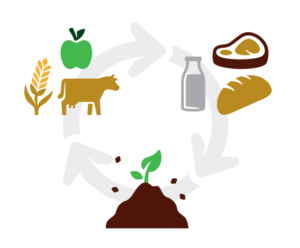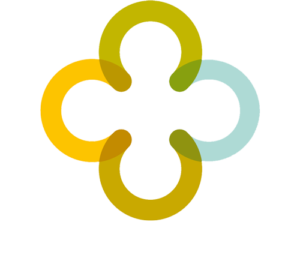Food transition
We staan voor grote maatschappelijke uitdagingen, waarbij het steeds duidelijker wordt dat het anders moet, ook binnen ons voedselsysteem.
Binnen de landbouw lag de focus lange tijd op economische efficiëntie en de productie van goedkoop voedsel. En met succes, de productie ging omhoog en de prijs omlaag. Binnen dit systeem zijn de boeren, de bodem, de natuur en de biodiversiteit met zijn ecosysteemdiensten echter in de knel komen te zitten. Door veranderend landgebruik is de biodiversiteit sterk achteruit gegaan, is de bodem verarmd en zijn ecosysteemfuncties afgenomen. Veel boeren zitten klem tussen hoge schulden aan de bank en lage prijzen van de supermarkt, tussen natuurbeschermers en de overheid.
Kringlooplandbouw en Deltaplan Biodiversiteit
Omdat het anders moet zijn verschillende partijen samen met het “Deltaplan Biodiversiteit” gekomen en heeft Carola Schouten, Minister van Landbouw, Natuur en Visserij haar visie op kringlooplandbouw gepresenteerd.
kringlooplandbouw streeft ernaar om de kringlopen van grondstoffen te sluiten en efficiënt gebruik te maken van reststromen als veevoer.
Het Deltaplan Biodiversiteit stimuleert natuur-inclusieve landbouw, die in samenhang is met de natuur en een positieve bijdrage levert aan het herstellen van de biodiversiteit.

Afbeelding kringlooplandbouw. (Min. LNV)
Alternatieve verdienmodellen
Voor beide benaderingen moet de huidige landbouw worden omgevormd naar een minder intensieve landbouw zonder dat de boer hierdoor extra onder druk komt te staan. Alternatieve verdienmodellen, waarbij boeren worden beloond voor de bijdragen die zij aan de biodiversiteit en ecosysteemdiensten leveren, zijn dan belangrijk. Het Gemeenschappelijk Landbouw Beleid (GLB) moet hiervoor worden herzien, waarbij de bijdragen die de boer levert en niet het aantal hectare wordt beloond. Banken moeten deze boeren rentekorting gaan geven en waterschappen moeten hun belastingen voor deze boeren verlagen. Ook de consument, de gehele keten en de overheid moeten een bijdrage leveren zodat de boer een eerlijke prijs voor zijn producten krijgt.
In haar visie stelt de Minister dat:
"Als consumenten weten waar hun voedsel vandaan komt en daardoor respect hebben voor producenten en product, helpt dat om tot minder verspilling en eerlijker prijs voor producten te komen. Korte ketens brengen boer en burger dichter bij elkaar."
Korte ketens
Voordelen korte ketens
Korte ketens vormen een belangrijk onderdeel van de kringlooplandbouw en natuurinclusieve landbouw benadering. Door waarde aan zijn producten toe te voegen en door producten direct aan de burger en lokale ondernemingen te verkopen kan de boer een betere prijs voor zijn producten krijgen. Studies van Wageningen UR laten zien dat voedsel, geproduceerd in de regio, een positief effect heeft op het inkomen van de boer. Het stimuleert de lokale economie, de koopkracht en werkgelegenheid op het plattelanden in de stad. Het verhoogt de waardering voor voedsel en het werk van de boer en brengt producent en consument dichter bij elkaar. Daarnaast vergroot het de toegang tot gezond voedsel en bevordert het een aantrekkelijke groene buitenruimte.
Vermenigvuldigingseffect
Het opzetten van alternatieve verdienmodellen en korte ketens draagt bij aan een eerlijke prijs voor de boer en stimuleert de lokale economie doordat het geld langer in de regio blijft. Dit komt mede door het vermenigvuldigingseffect dat ontstaat doordat onafhankelijke lokale ondernemingen hun verdiensten voor een groot deel (tot 80%) ook weer in de lokale economie uitgeven. Bij grote ketens en multinationals verdwijnt een groot deel uit de regio (80%) terwijl slechts 20% weer in de lokale economie wordt uitgegeven.
Vermenigvuldigingseffect or Multiply Effect
Burgers zitten ook klem
Om boeren minder intensief te laten boeren, moeten ook burgers een eerlijke prijs voor hun voedsel gaan betalen. We horen echter steeds vaker dat burgers niet meer voor hun voedsel willen betalen. Andere burgers zitten zelf ook klem, sommige in zogenaamde cognitieve dissonantie, waarbij ze wel willen, maar toch andere keuzes maken, anderen hebben gewoonweg niet het geld om de eerlijke prijs van voedsel te betalen. Steeds meer mensen leven namelijk onder de armoede grens en zijn afhankelijk van voedselbanken. Zijn korte ketens dan alleen voor de grachtengordel? In het huidige economische systeem misschien wel, maar daar kunnen we wat aan doen.

De voedseltransitie moet dan wel verder gaan dan het sluiten van de ecologische en nutriënten kringlopen. Net als de nutriënten kringlopen moeten ook de economische kringlopen en de kringlopen van ons geld gesloten worden.
Money as a nutrient for the economy and for the exchange of goods.
There are many similarities between the functioning of nutrients in an agro-ecological system and how money functions within a society. Where nutrients are needed for the production of sufficient and healthy food, money is the lubricant of our economy. It makes the exchange of goods, services and investments possible. Money is also the connection between nature, food and agriculture sectors, with the consumer and the various initiatives for sustainable and healthy agriculture. The food transition requires money to make investments and to pay the farmer a fair price for his work.
Money, in its current form, is not in the service of a sustainable and social society. On the contrary, it contributes to the current undesirable situation. If we look at money with agro-ecological glasses, we see that there is continuous erosion of money taking place from the real economy and rural areas.
"Continuous erosion of money out of our society and rural areas is taking place."

Money flows out of the local economy (Unitedeconomy)
Because interest rates and purchases via the internet, at large chains and in the city, money flows out of the local economy. This makes it more difficult to do business and to invest in the food transition. It also influences the purchasing power of consumers and thus the success of short-chain initiatives.
Interest rates on money also stimulate a continuous demand for the economy to grow, increasing the pressure on our raw materials. Interest rates also means that sustainable investments are not always financially profitable, so that less sustainable alternatives are chosen.
Is an investment with interest rate similar to plowing a field?
Plowing has long been used to increase soil productivity, but it is becoming increasingly clear that this also stimulates erosion and emissions making it not sustainable in the long term (no tillage is the alternative).
You can look at investments with interest in the same way. In the short term, investments can stimulate the development of sustainable agriculture, but there is something unsustainable in the underlying mechanisms that stimulates the "erosion" of money. It also makes it more difficult for the farmer to earn a good sandwich and to ensure a higher price for our food.
In short, money in its current form is therefore anything but circular and will slow down the transition rather than to accelerate a circular agriculture and circular economy. For the realization of a circular agriculture and a circular economy, we therefore also have to transform the functioning of money. We must look at how we can close the cycles of money, locally where possible, regionally or internationally where necessary.
Complementary-, circular-, local-, circular- or regenerative money
Just like with the block-chain technology you can provide information to money, for example that it can only be spent in a certain region. Compare it with nutrients that you provide with information that they can only leave the farm in the form of high-quality food. In agriculture this will make it easier to realize circular agriculture, within our economy it will be easier to realize a circular aconomy.
With local money, purchasing power does not leak out of the region, local money ensures that it goes around more often. This creates a whole chain of transactions that stimulates purchasing power and the multiplication effect. Local money ensures more economic activities, employment and purchasing power in the region.

Money stays within the local economy (Unitedeconomy)

These illustrations show how new technology gives money more impact on the regional economy. The black arrows are euros. Money normally flows quickly out of the region (Figure 1). Once exchanged for local circular money (gray arrows), this money is digitally instructed to stay local for a certain period of time (Figure 2). This means that this purchasing power is better used locally and used more often (Figure 3). At the end of the period, ordinary euros can be bought with the local money and can be spent everywhere again (Figure 4). (STRO)
Combining the potential of local food chains and local money
Combining short chain initiatives with a local currency, stimulates the local economy and social cohesion, makes the region more resilient and greatly increases the chances of success of food initiatives.
This makes it easier for consumers to buy healthy and sustainable food and pay the farmer a fair price for this. This allows the farmer to invest in more sustainable production resources such as recycled agriculture and nature-inclusive agriculture. This also encourages the farmer to produce a more diverse range of products, add value and focus more on his own region through short chains. His neighbors have more to spend and can more easily pay the fair price for their products.
With circular or local money you know that the "money" that you spend stays local and thus triggers a chain of transactions that can indirectly end up with you again.
A little help to buy locally
Besides increasing the purchasing power, local money creates awareness about the functioning of money and the importance of the local economy. It stimulates a change in behaviour from individual thinking, where is the food the cheapest, from group thinking, how do my purchases contribute to the local economy. Local purchases are stimulated because the citizen knows that the local money that he/she spends stays local and thus initiates a chain of transactions that stimulates the local economy and can indirectly return to him or her. This closes the cycle of transactions so that it can start again. In the meantime, it created many extra economic activities, extra sales and extra tax revenues. Therefore, the intrinsic value of the money, the value the money created is multiplied.
"Local what is possible, regional or international what is necessary."
Providing subsidies (partly) in local money?
Local money subsidies also stay in the region longer and provide a chain of economic activities. The effect of subsidies in the region is therefore much greater. Imagine that part of the budget to realize short chains or a circular economy in your region is paid in local money. This encourages the receiving party to approach local companies and institutions to provide the desired services, knowledge and technology. Maybe not everything is available locally, but where it is possible, this ensures for involvement and stimulates the regional economy. The effect on the regional economy is that there is more room for farmers and entrepreneurs to invest in adding value to the products. Closing the cycle, these extra economic activities also ensure that there is more tax revenue, so that there may be more room for subsidies.
Loans in local money?
The same goes for bank loans. Within the Dutch local money network there is currently room for interest-free loans of up to 5000 euros for investment. However, as the local money network grows, it becomes possible to borrow more. This credit, on which no interest has to be paid, is paid in local money and therefore benefits the local economy. The credit remains in the region and can therefore flow back to the debtor himself. This increases the chance that the loan can be paid off and the investment is therefore a success.
Combining the potential of local food chains and local money
GOOD FOOD IN BRISTOL
In Bristol, "Good Food" means a lot of attention for locally produced food. Many citizens are involved in green initiatives and by purchasing locally produced food, local producers are encouraged. Certainly if the Bristolpound is used to pay, the money stays in the Bristol region, creating more employment.
A must to see!
Sardex in Sardinie (Italy)
In Sardinië heeft de Sardex ervoor gezorgd dat boeren in tijd van crisis toch hun producten konden verkopen doordat de Sardex de locale economie stimuleerde.
Bangla-Pesa in Kenya
Grassroots Economics develops local money systems in Africa. Bangla-Pesa is a successful example from Kenya. Also watch the documentary about Will Ruddick and Bangla-Pesa: https://bit.ly/2QLIO3M
Bristol Pound in Bristol
The Bristol Pound is the best known local coins in Europe. The Bristol Pound reinforces the pride of the citizens in their city!
Local Money Initiatives in the Netherlands & the coin the United for sustainable trade
DE OMMUURDE TUIN & the Eurijn
As a CSA, the walled garden has an alternative business model with a local market and its own shop / cafe. You can pay for these products with the local currency the Eurijn. If you pay something with Eurijnen you know that they will also be spent in the Foodvalley Region. Watch the video to learn why she is participating.
Bekijk de video om te leren waarom ze mee doet.
Watch the video to learn why she is participating.
In the Netherlands there are various food-related companies that use local money.
These are them in Wageningen and the Foodvalley Region:
"At the Root" is an initiative of Emil Kuijs by Kuijseffect
“At the Root” creates awareness about the food transition and about the potential of local money within local food chains. The aim is to promote local money within short chain initiatives and to give a platform for initiatives for a short chain that use local money.
In this way, "At the Root" wants to contribute to a real food transition whereby farmers receive a fair price for their products and can produce good food in balance with nature .
Waar ben ik naar op zoek:
1At the Root is op zoek naar een pilot project, bijvoorbeeld een natuur inclusieve, kringlooplandbouw, korteketen, alternatieve verdienmodellen, greendeal project, die binnen het project, lokaal geld wil gaan gebruiken. In Utrecht, Alkmaar en Regio Foodvalley, zou aansluiting gevonden kunnen worden bij reeds bestaande lokale munten.
2 Een project opzetten om video’s te maken van voedsel gerelateerde initiatieven en ondernemers die nu al lokaal geld gebruiken. Dit heeft als doel deze initiatieven en ondernemers op de kaart te zetten. Een voorbeeld video is die van de Ommuurde Tuin: https://www.
Emil Kuijs is an ecologist and filmmaker and has an interest in the interface between ecology and sociology, in other words, where man and nature come together. He is enthusiastic to (agro) ecological principles in these complex systems to apply and come up with solutions to their systems and processes to create fairer and more sustainable. In Wageningen he has focused on the socio-ecological system around the national and international development and food issues addressed. Certainly in the Netherlands, agriculture is an area where nature and people come together and are largely dependent on each other.
Do you want to know more about the potential of local money, with a video on this website, use local money or support this project? Then contact us.
Contact
- attherootlmf@gmail.com
- (+31) 649943130
- www.kuijseffect.com



